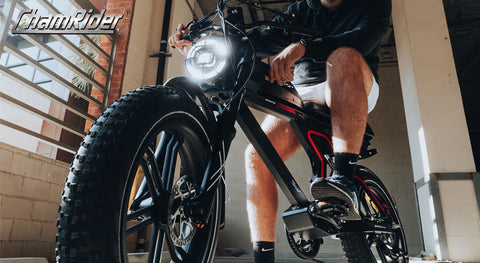Electric bicycles have the potential to change the game by reducing our reliance on cars and transforming the way we commute. However, while accidents are rare and shouldn't discourage you from investing in an electric bike, it's important to be aware of the potential fire hazards associated with large lithium-ion batteries installed on the bike frame.
Lithium-ion batteries offer many advantages that make them an ideal choice for electric bicycles. They can be charged and discharged hundreds of times, are relatively lightweight and compact, and contain lower levels of toxic heavy metals compared to many other battery types. Unfortunately, they are also highly flammable.
Why do electric bicycles pose a fire risk?
The lithium-ion batteries used in electric bicycles consist of two electrodes separated by an electrolyte. During charging or discharging, charged ions move from one electrode to the other.
The electrolyte in lithium-ion batteries is highly flammable. While this is generally not a problem, if the battery is damaged or overheated, the liquid may ignite. Once one battery overheats, adjacent batteries can also overheat (a process known as thermal runaway), and the heat and pressure quickly become uncontrollable, leading to an explosion.
To understand the reasons behind such incidents, TechRadar interviewed the Fire Protection Research Foundation, the research affiliate of the National Fire Protection Association (NFPA).
The project manager at the foundation explained that there are various causes for lithium-ion battery fires, including manufacturing defects, design flaws, improper usage (such as placing the battery near a heat source or exposing it to prolonged direct sunlight, which can lead to overheating), puncturing the battery in a way that causes a short circuit, and using chargers that are not suitable for the device.
These issues are not unique to electric bicycles—any device with lithium-ion batteries can potentially catch fire, as we have seen with smartphones, laptops, and electric cars.
Hoverboards, in particular, have gained notoriety. Since their popularity surged in 2015, the U.S. Consumer Product Safety Commission (CPSC) has reported over 250 incidents related to fires or overheating. Major airlines have banned hoverboards from commercial flights, and retailers like Amazon, Overstock, and Toys "R" Us have temporarily halted sales.
Electric skateboards are particularly susceptible because they are relatively new and lack design standards that mandate safety measures such as venting holes or separators that act as fuses and shut off the battery at certain temperatures. Unlike other devices with lithium-ion batteries, they have not undergone rigorous testing before being sold to the public.
The U.S. Consumer Product Safety Commission swiftly implemented safety standards for hoverboards, and although their use on airplanes is still prohibited, hoverboards quickly made a comeback on store shelves.
Electric bicycles have been around for a long time and have more mature standards. However, the Fire Protection Research Foundation explains that bicycles involved in fires often have poor manufacturing quality:
"According to anecdotal reports from some fire departments, such as the New York City Fire Department, many electric bicycle fires are caused by low-quality components (such as poorly controlled batteries or products not certified by independent testing laboratories)."
How to prevent electric bicycle fires
In addition to purchasing electric bicycles from reputable manufacturers that meet appropriate safety standards, there are some measures you should take to maintain your electric bicycle and prevent fires:
Read the user manual and follow the manufacturer's safety precautions.
Only use chargers provided by the brand that are compatible with the battery.
Avoid using power extension cords; plug the charger directly into a wall outlet.
Ensure you have smoke detectors installed in the area where you charge your electric bicycle, and that you can hear the alarm. For example, if you charge your electric bicycle in a garage or garden shed, make sure a smoke detector is installed there and can be heard from your house.
If your battery or electric bicycle is exposed to a flood, consider it permanently damaged and do not attempt to charge it. Dispose of it responsibly.
Thorpe also suggests considering recycling the battery of your electric bicycle after five years, regardless of its usage. "Electric bicycle technology is changing and advancing each year," he says.
Lastly, he warns against keeping old lithium-ion batteries at home—whether they are from electric bicycles or not. Instead, responsibly recycle them.
The National Fire Protection Association (NFPA) has its own safety tips for lithium-ion batteries, providing information on the safe use of products powered by lithium-ion batteries and guidance on what to do in case of a lithium-ion fire. It also offers specific guidance for electric bicycle owners, including:
Do not use aftermarket batteries.
Always use the power cord and power adapter specifically made by the manufacturer for the device.
Do not leave the electric bicycle unattended while charging.
Do not leave the electric bicycle charging overnight.
Store batteries and devices at room temperature. Extreme heat or cold temperatures can damage the batteries. It is also not recommended to leave them in direct sunlight.
Do not keep electric bicycles (or similar devices) in children's rooms.
Do not block main exits of buildings with electric bicycles (or similar devices).
What to do in case of a fire
Pay attention to the battery of the electric bicycle, as you may be able to identify warning signs before a fire occurs. If you notice strange odors, changes in shape, leaks, unusual noises, or excessive heat, NFPA recommends moving it away from anything that could catch fire (if possible) and calling the fire department.
If a fire does occur, do not attempt to extinguish it yourself; lithium battery fires are particularly hazardous as the battery casing can explode at high temperatures, posing the risk of flying debris. Instead, evacuate the area immediately and call emergency services.
By following the safety guidelines above, the risk of a fire is minimal, which should not deter you from purchasing an electric bicycle. However, if a fire does occur, leave it to the professionals.







ความคิดเห็น (0)
ไม่มีความคิดเห็นสำหรับบทความนี้ เป็นคนแรกที่ฝากข้อความ!